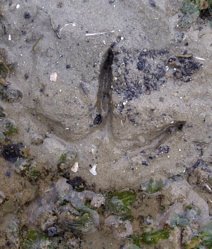Forensic Birding 1: Introduction
We were introduced to forensic birding by Lin Yangchen when he wrote on 30th December 2005:
“Birds are usually identified by sight or sound. It may also be possible to identify them from the tracks, feathers and droppings they leave behind. It is not always possible to pinpoint the species but the genus or family may be established. Looking out for signs is one challenge and interpreting them is another.
“For example, tracks can divulge much information through the presence or absence of claws and webbing, the number and apparent relative lengths of toes, angle between toes II and IV etc. The arrangement of a series of tracks can reveal characteristic gaits and whether the bird was walking, running or hopping. Slightly unfortunate, bird tracks are usually found only on the ground in silt, mud or snow.
 “Cracked nuts, half-pecked fruits and pellets might tell us about diets and feeding guilds while the condition of a bird skeleton might tell us how the bird met its demise (cat, bird-eating spider, car accident etc).
“Cracked nuts, half-pecked fruits and pellets might tell us about diets and feeding guilds while the condition of a bird skeleton might tell us how the bird met its demise (cat, bird-eating spider, car accident etc). “This is a fascinating subject either for research or for fun, as the eggs of the warring crows and koels have demonstrated.
“Since the days when the wild regions of the Malay Peninsula were largely unknown, explorers have taken a keen interest in the evidence left by animals. For example, *Skeat (1908) observed 'peculiar open spaces several yards square and absolutely devoid of leaves and rubbish' along a ridge on Gunung Tahan. The footnote reads, 'they are nothing more than the playing-grounds of the Argus Pheasant'".
Responding, Benjamin Lee wrote, “Thanks for the enlightening account of avian CSI. And let's not forget the application of avian forensics in determining species causing aircraft engines to fail during a bird strike. Dr Jon Baldur Sigurdsson, who used to teach ornithology in the former Department of Zoology, National University of Singapore, was a consultant to bird strike cases at Changi Airport. He had to determine what sort of birds were killed by looking at the remains of feathers, bones and bits of skin.
There is an excellent review article here on everything you want to know about aircraft and bird strikes. This article is reproduced from "The Auk", an American ornithological journal, and was authored by Prof. Navjot Sodhi from the National University of Singapore."
See also "Tales of a Birding Pilot".
Wang Luan Keng followed with a workshop on 20th January 2006 when she brought specimens of feathers and wings, eggs, skeleton pieces, whole bird specimens, etc for participants to handle and ask questions. The evening proved to be an exciting introduction to forensic birding with participants showing much interest and asking numerous questions.
Obviously there is a wide-open field out there for birders to look into. Birding is not and should not be confided only to identifying birds and counting them. Birders, when out in the field, should also look out for bird tracks, splats, discarded eggs and shells, make the necessary records and bring them up for discussion later.
Input by Lin Yangchen, Benjamin Lee and Wang Luan Keng. Image by Lin Yangchen.
*Skeat, W. W. 1908. A personal reconnaissance of Gunung Tahan. Journal of the Federated Malay States Museums 3:77-90.
Labels: Interspecific



3 Comments:
this is so interesting. this is what i've been looking forward for this sort of experience in each of my trip to birding spot. *sigh* i'm so far away from you guys...
Distance is no barrier, Weng Chun. Join us in our discussion and contribute to the blog. Your encounters are always fascinating. I will send you an invite to our e-loop. Others are also welcome. YC
Some countries analyse bird strike remains as a matter of course. In the UK, bird strike remains are sent to the Central Science Lab and in the US they go to the Smithsonian.
Post a Comment
<< Home